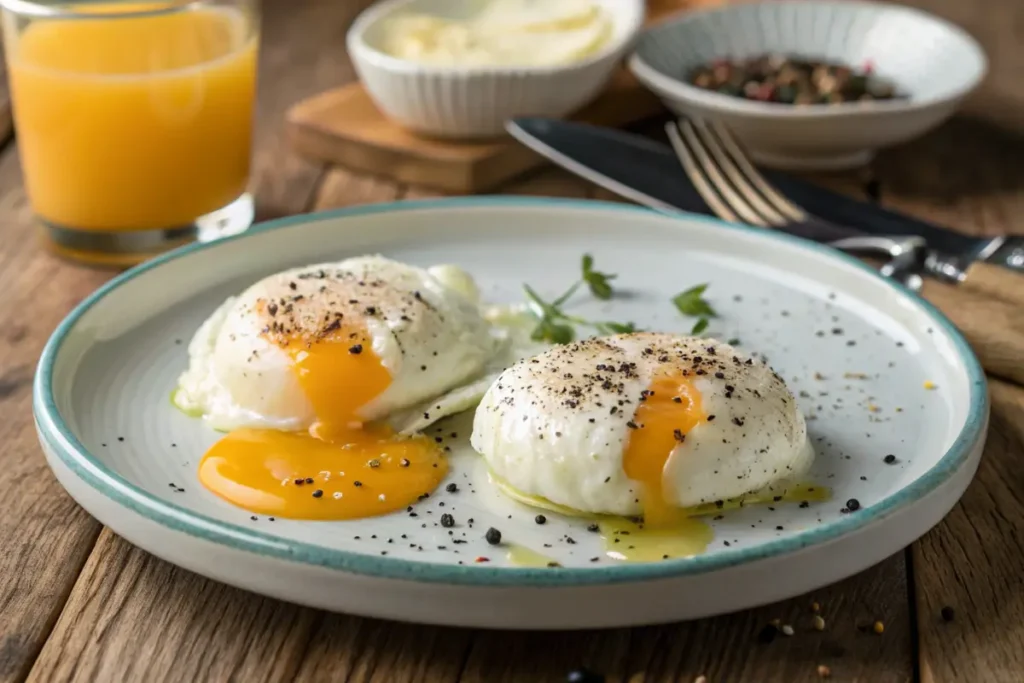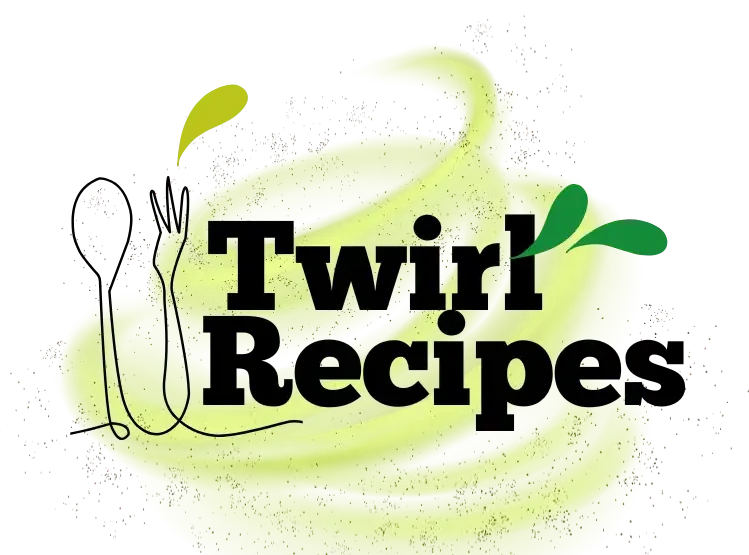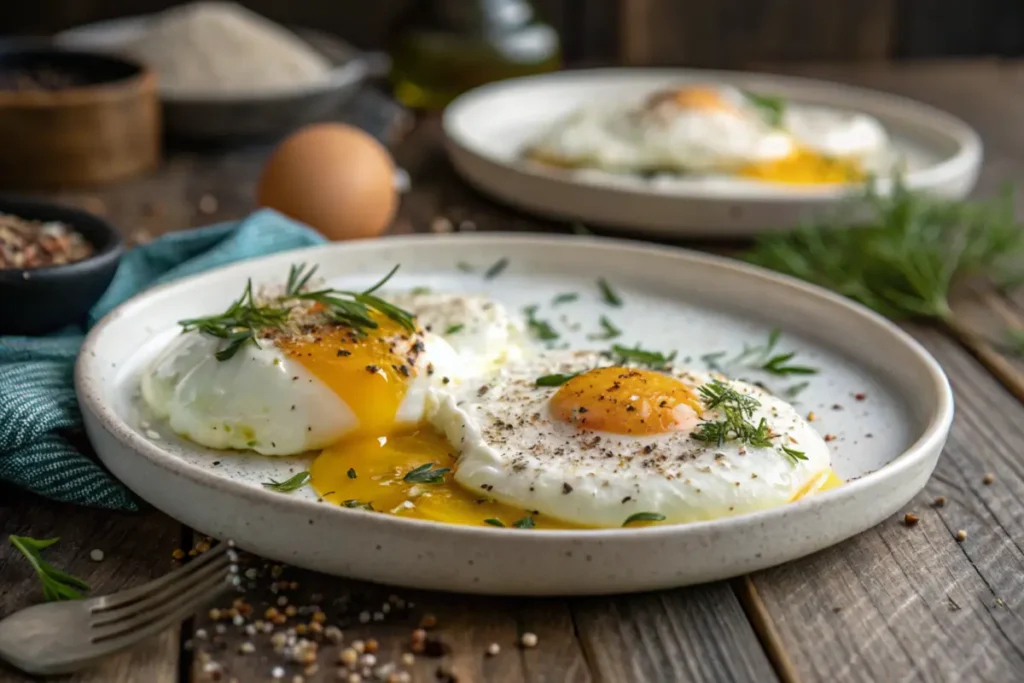Perfecting over medium eggs requires more than just cracking an egg into a pan. This process ensures fully set whites and slightly runny yolks, striking a delicate balance between technique, timing, and finesse. In this article, we’ll explore every detail, from selecting the best equipment to troubleshooting common challenges, ensuring that your over medium eggs turn out perfect every time. Let’s dive into the intricacies of this cooking method, starting with a closer look at what defines over medium eggs.
JUMP TO
What Are Over Medium Eggs?
Over medium eggs are a popular fried egg preparation where the whites are fully set, yet the yolk remains soft and slightly runny, offering a perfect texture for those who enjoy richness without excessive drips. They’re a step beyond over easy eggs and just shy of over hard eggs.
This particular doneness is favored for its versatility; it works beautifully as a standalone breakfast item, a topping for savory dishes, or a star ingredient in sandwiches. The appeal of over medium eggs lies in their consistency and ability to complement various meals without overpowering flavors.
Differences Between Egg Doneness Levels
Understanding egg doneness is key to mastering the over medium eggs technique. Each level caters to specific tastes and textures:
Sunny-Side Up: The egg is cooked on one side, leaving the yolk completely runny with barely set whites. Ideal for a light, delicate texture.
Over Easy: Flipped once, the yolk remains entirely runny while the whites are just set. This preparation appeals to those who love a creamy, liquid yolk.
Over Medium: Flipped and cooked slightly longer, resulting in firm whites and a semi-liquid yolk that holds its shape when cut. Perfect for a balanced bite.
Over Hard: Flipped and cooked until both the whites and yolk are firm, with no liquid remaining. A hearty, fully cooked option.
Recognizing these subtle differences helps you adapt your approach to achieve the exact doneness you desire. Whether you’re a fan of dipping toast into a golden yolk or prefer firmer textures, there’s an egg style for you.
Preparing to Cook Over Medium Eggs
Choosing the Best Cooking Fat for Over Medium Eggs
The choice of fat impacts the flavor, texture, and crispiness of your eggs. It’s a small decision that makes a big difference.
Butter: Butter adds a rich, creamy flavor and helps achieve crispy edges. It’s ideal for those who enjoy a slight nuttiness in their eggs, thanks to the browning effect of butter when heated.
Oil: Neutral oils like vegetable or canola oil work well if you prefer a cleaner taste. For those looking to add depth, olive oil or avocado oil provides a unique flavor profile. Their higher smoke points also make them suitable for consistent frying.
Non-Stick Spray: While convenient, cooking sprays may not provide the same depth of flavor as butter or oil. Use them as a quick option when short on time.
Regardless of the fat you choose, ensure it is evenly spread across the pan for consistent cooking. Heat it until it’s hot but not smoking to prevent burning or uneven cooking.
Setting the Stage for Success
Preparation doesn’t end with tools and fat. Ensure your eggs are fresh, as fresher eggs have firmer whites and yolks that hold their shape better. Crack the eggs into a small bowl beforehand to avoid breaking the yolk or letting eggshells slip into the pan.
By taking these simple steps, you’ll create the perfect conditions for crafting flawless over medium eggs. Ready to move to the cooking process? Let’s tackle the technique in the next section.
Step-by-Step Guide to Cooking Over Medium Eggs
Making over medium eggs requires attention to detail and a careful balance of heat and timing. Follow these steps to achieve eggs with set whites and jammy yolks every time.
Step 1: Heating the Pan
Begin by preheating your skillet over medium heat. This is crucial—too hot, and the eggs might burn before cooking evenly; too cool, and the whites may stick to the pan or cook inconsistently.
Once the pan is warm, add your chosen fat. Whether it’s butter or oil, make sure it coats the entire surface of the pan evenly. Heat the fat until it’s hot but not smoking. For butter, this means it should melt completely and start to foam slightly, but avoid letting it brown too much.
Step 2: Adding the Eggs
Cracking eggs directly into the pan can risk breaking the yolks or causing uneven cooking. Instead, crack each egg into a small bowl or ramekin first. This ensures the yolk stays intact and lets you remove any stray shell pieces easily.
Gently slide the eggs from the bowl into the heated skillet. Space them apart to avoid the whites merging together unless you’re aiming for a specific presentation, like stacked eggs on toast.
Step 3: Cooking the First Side
Cook the eggs undisturbed on the first side. As the whites begin to set, you’ll notice the edges crisping up—this takes about 2–3 minutes. During this time, resist the urge to move the eggs around, as this can disturb their shape.
If the whites around the yolk are taking longer to set, gently spoon some of the hot fat from the pan over the whites. This speeds up cooking without overcooking the yolk.
Step 4: Flipping the Eggs
Flipping the eggs is where the magic happens—and it can be nerve-wracking! To do this successfully, use a thin spatula and a gentle hand. Slide the spatula carefully under the egg, ensuring you get beneath the yolk.
Lift the egg slightly off the pan, then flip it over in one smooth, confident motion. The goal is to keep the yolk intact while allowing the whites to flip cleanly. If this step feels daunting, practice with a slightly cooler pan or use the lid method (described below) to avoid flipping altogether.
Step 5: Cooking the Second Side
Once flipped, cook the eggs on the second side for 1–2 minutes. This will ensure the whites are fully set while leaving the yolk slightly runny. If you prefer a firmer yolk, extend the cooking time by an additional 30–60 seconds, but keep a close eye to avoid overcooking.
When the yolk reaches your desired consistency, carefully remove the eggs from the pan using the spatula and serve immediately.
Alternative No-Flip Method
If flipping feels intimidating, you can achieve over medium eggs without turning them. Cover the skillet with a lid after adding the eggs. The steam created will cook the tops of the whites and yolks evenly. This method results in a similar texture and saves you from flipping-related stress.
Cooking over medium eggs might require practice, but mastering this technique opens the door to a world of delicious breakfast possibilities. Up next, we’ll explore ways to serve and enjoy these perfectly cooked eggs.
Serving Suggestions
Once you’ve cooked flawless over medium eggs, the fun part begins—deciding how to serve them! These versatile eggs are more than a breakfast staple; they can elevate a variety of dishes, from hearty classics to creative culinary experiments. Let’s explore some serving ideas to inspire your next meal.

Classic Pairings for Over Medium Eggs
Sometimes, simplicity is best. Classic combinations highlight the rich texture and flavor of over medium eggs, making them the star of the plate.
Toast and Eggs: Place your over medium eggs on a slice of buttery, toasted bread for a timeless breakfast. Sprinkle with a pinch of salt and freshly cracked pepper for a simple, satisfying meal.
Potatoes: Pair the eggs with crispy hash browns or roasted potatoes. The soft yolk acts as a luscious sauce, adding depth to every bite.
Sourdough Creations: Adding eggs to sourdough not only enriches the bread’s flavor but also improves its structure by making it softer and more tender. This pairing creates a harmonious balance of textures and works beautifully with over medium eggs for a wholesome and flavorful breakfast or brunch.
Vegetables or Proteins: A side of sautéed vegetables, grilled asparagus, or even savory proteins like sausage enhances the creamy yolk and crispy whites beautifully.
Rice or Grain Bowls: In many cuisines, eggs served over rice or grains make a comforting and nutritious meal. Add a drizzle of soy sauce or a sprinkle of fresh herbs for an international twist.
Creative Uses for Over Medium Eggs
For those who love experimenting in the kitchen, over medium eggs can add richness and visual appeal to inventive dishes.
Egg-Topped Burgers: Add an egg to your burger for a gourmet touch. The yolk’s semi-runny texture creates a velvety sauce that enhances every bite.
Salad Enhancements: Incorporate over medium eggs into a fresh salad for extra protein and flavor. The creamy yolk mingles with the dressing, creating a luxurious, cohesive dish.
Tacos and Wraps: Use over medium eggs as a filling for breakfast tacos or wraps. Pair them with avocado slices, salsa, and a sprinkle of cheese for a handheld meal that’s bursting with flavor.
Grain Bowls and Stir-Fries: Top quinoa, couscous, or stir-fried vegetables with an egg. The slight richness balances the dish, making it both satisfying and wholesome.
Next, we’ll tackle some common challenges and tips for troubleshooting to ensure consistent success with every batch of over medium eggs.
Tips and Troubleshooting
Cooking over medium eggs may seem simple, but achieving consistent results can take practice. From preventing broken yolks to managing heat levels, troubleshooting common issues ensures your eggs turn out perfectly every time. Here are some tips to guide you through the process.
Ensuring Yolks Stay Intact
One of the biggest challenges when cooking over medium eggs is keeping the yolks intact, especially during flipping.
- Use Fresh Eggs: Fresher eggs have firmer whites and yolks that are less prone to breaking. Check the sell-by date to ensure freshness.
- Handle Gently: Avoid cracking the egg directly onto the pan. Instead, crack it into a small bowl first, then slide it carefully into the skillet.
- Master the Flip: A confident, smooth motion is key. Slide the spatula fully under the egg, making sure it supports the yolk, and flip it in one quick motion to prevent breakage.
Managing Heat Levels
Heat control is vital for over medium eggs. Too high, and the edges may burn before the whites set; too low, and the yolks may overcook.
- Use Medium Heat: Medium heat is perfect for cooking eggs evenly without scorching them. Preheat the skillet thoroughly before adding the eggs.
- Adjust Cooking Time: If the yolk is too runny, add an extra 15–30 seconds of cooking time on the second side. If it’s too firm, reduce the cooking time slightly on future attempts.
Troubleshooting Uneven Cooking
Sometimes, the whites may cook faster than the yolk or develop rubbery edges. To address this:
- Use the Lid Method: Cover the skillet with a lid after adding the eggs to trap steam and cook the tops evenly.
- Spoon Hot Fat Over the Whites: Basting the whites with hot butter or oil from the pan helps them set quickly and evenly.
Up next, let’s conclude this guide with additional insights to enhance your egg-cooking skills and inspire creativity in the kitchen!
Conclusion: The Perfect Over Medium Egg Awaits
Cooking over medium eggs is an art that, with a little practice, becomes second nature. From achieving fully set whites to mastering that luscious, jammy yolk, this egg style offers a balance of texture and flavor perfect for any meal.
With the right tools, techniques, and a touch of creativity, you can elevate your breakfast or add flair to other dishes. Embrace the process, experiment with pairings, and enjoy the satisfaction of creating perfectly cooked over medium eggs every time. Happy cooking!
Frequently Asked Questions
Are over medium eggs healthy?
Yes, over medium eggs are a nutritious choice! They’re an excellent source of protein, healthy fats, vitamins (like B12), and essential minerals such as iron. The semi-cooked yolk retains many nutrients that might be lost in overcooked eggs, making them a wholesome addition to any meal.
Is it bad to eat overcooked eggs?
While eating overcooked eggs isn’t harmful, the texture and flavor may suffer. Overcooked whites can become rubbery, and yolks may turn chalky or develop a greenish hue due to a harmless reaction between iron and sulfur. For the best flavor and nutrition, aim for proper doneness.
How to crack an egg?
Cracking an egg cleanly takes a little finesse:
- Hold the egg firmly but gently.
- Tap it on a flat surface to create a crack, avoiding jagged edges.
- Pry it open with your thumbs over a bowl, allowing the egg to drop cleanly without breaking the yolk.
Can I make over-medium eggs without flipping them?
Absolutely! Using the no-flip method is a great alternative. Simply cover the skillet with a lid after adding the eggs. The steam will cook the tops of the whites and yolk, mimicking the effect of flipping while eliminating the risk of breaking the yolk.

